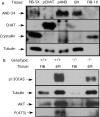Loss of AND-34/BCAR3 expression in mice results in rupture of the adult lens
- PMID: 19365570
- PMCID: PMC2666772
Loss of AND-34/BCAR3 expression in mice results in rupture of the adult lens
Abstract
Purpose: AND-34/BCAR3 (Breast Cancer Anti-Estrogen Resistance 3) associates with the focal adhesion adaptor protein, p130CAS/BCAR1. Expression of AND-34 regulates epithelial cell growth pattern, motility, and growth factor dependence. We sought to establish the effects of the loss of AND-34 expression in a mammalian organism.
Methods: AND-34(-/-) mice were generated by homologous recombination. Histopathology, in situ hybridization, and western blotting were performed on murine tissues.
Results: Western analyses confirmed total loss of expression in AND-34(-/-) splenic lymphocytes. Mice lacking AND-34 are fertile and have normal longevity. While AND-34 is widely expressed in wild type mice, histologic analysis of multiple organs in AND-34(-/-) mice is unremarkable and analyses of lymphocyte development show no overt changes. A small percentage of AND-34(-/-) mice show distinctive small white eye lesions resulting from the migration of ruptured cortical lens tissue into the anterior chamber. Following initial vacuolization and liquefaction of the lens cortex first observed at postnatal day three, posterior lens rupture occurs in all AND-34(-/-) mice, beginning as early as three weeks and seen in all mice at three months. Western blot analysis and in situ hybridization confirmed the presence of AND-34 RNA and protein in lens epithelial cells, particularly at the lens equator. Prior data link AND-34 expression to the activation of Akt signaling. While Akt Ser 473 phosphorylation was readily detectable in AND-34(+/+) lens epithelial cells, it was markedly reduced in the AND-34(-/-) lens epithelium. Basal levels of p130Cas phosphorylation were higher in AND-34(+/+) than in AND-34(-/-) lens epithelium.
Conclusions: These results demonstrate the loss of AND-34 dysregulates focal adhesion complex signaling in lens epithelial cells and suggest that AND-34-mediated signaling is required for maintenance of the structural integrity of the adult ocular lens.
Figures









References
-
- Cai D, Clayton LK, Smolyar A, Lerner A. AND-34, a novel p130Cas-binding thymic stromal cell protein regulated by adhesion and inflammatory cytokines. J Immunol. 1999;163:2104–12. - PubMed
-
- Gotoh T, Cai D, Tian X, Feig L, Lerner A. p130Cas regulates the activity of AND-34, a novel Ral, Rap1 and R-Ras guanine nucleotide exchange factor. J Biol Chem. 2000;275:30118–23. - PubMed
-
- Cai D, Felekkis KN, Near RI, O'Neill GM, van Seventer JM, Golemis EA, Lerner A. The GDP exchange factor AND-34 is expressed in B cells, associates with HEF1, and activates Cdc42. J Immunol. 2003;170:969–78. - PubMed
Publication types
MeSH terms
Substances
Grants and funding
LinkOut - more resources
Full Text Sources
Molecular Biology Databases
Research Materials
